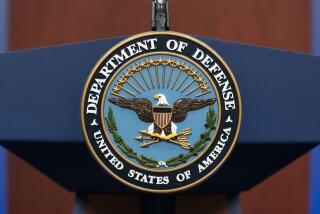Demand for U.N. Peacekeeping Forces Grows
- Share via
UNITED NATIONS — More Blue Helmets may patrol the world’s political minefields this year than ever before in the 44-year history of United Nations peacekeeping.
A force of 10,000 destined for Cambodia and a potential 10,000 for Yugoslavia will join more than 13,000 peacekeepers already in war zones from Central America to Southeast Asia, from Angola to Kashmir.
“There have been almost as many operations in the past four years as in the first 40 years of peacekeeping, and the demand will grow,” says Marrack Goulding, U.N. undersecretary general for special political affairs. Peacekeeping this year is expected to cost more than $1 billion. More than one-third of the 170 U.N. member nations now contribute peacekeeping troops.
The United Nations just expanded its force in El Salvador from 135 to 1,000 after a peace agreement and cease-fire that ended a savage 12-year civil war. “We are deeply involved in the remodeling of El Salvador,” Goulding says.
In Cambodia, “we’ll be running--not simply monitoring--elections for the first time,” he says. The Cambodian operation, the most complex ever undertaken, will patrol a cease-fire line, help reconcile the four warring factions and resettle several hundred thousand refugees.
The United Nations will practically help govern Cambodia while the country is reconstructed after its brutal 13-year conflict. But the peacekeeping force will not be the biggest ever. Nearly 20,000 troops were deployed to the violence-torn Congo in the early 1960s.
In Western Sahara, peacekeepers will maintain a cease-fire and supervise a yet-to-be-scheduled referendum on whether the former Spanish colony will be independent or part of Morocco.
The possible mission in bloodied and broken Yugoslavia, after 15 cease-fires, would be the first ever in Europe and the 11th current operation worldwide.
The blue-helmeted peacekeepers have enjoyed a high profile since collectively winning the 1988 Nobel Peace Prize. Demand for them has increased because of the end of the Cold War, subsequent cooperation between Russia and the United States and more governments turning to the United Nations to help settle regional disputes.
Since last year’s Persian Gulf War, 300 military observers have been monitoring the demilitarized zone between Iraq and Kuwait.
Peacekeeping has become more complex since the early missions of simply patrolling cease-fire lines. And peacekeeping forces are more global.
“Within the past four years, the number of troop-contributing countries has doubled, to about 60,” Finnish Col. Heikki Purola, deputy military adviser to the secretary general, said.
The wider geographic makeup, with countries as small as Fiji and Nepal involved, has expanded forces beyond the traditional Nordic nucleus of Finland, Norway, Sweden and Denmark.
Peacekeepers, either lightly armed troops or unarmed observers, are deployed only after a cease-fire is holding and rival groups have consented.
“What was often criticized about peacekeeping in the early days was that it would simply supervise the cease-fire, and that would just freeze the status quo. Peacekeeping tended to become permanent,” says Hisako Shimura, director of the special political affairs office.
“Recent operations combine to a much larger extent peacekeeping and peacemaking,” Shimura says. About 8,000 military and civilian peacekeepers were sent to Namibia, for example, to assist Namibian independence in 1990 through elections and the formation of a government.
Cyprus is classic peacekeeping. More than 2,000 troops still patrol a 1974 cease-fire line that cuts across the island to separate Greek and Turkish enemies.
The first peacekeeping operation, begun in 1948 after Arab-Israeli hostilities over the new state of Israel, is also the longest-running.
In neighboring missions, about 6,000 peacekeepers are positioned in southern Lebanon, and more than 1,300 are maintaining the cease-fire between Israel and Syria along the Golan Heights.
More than 700 peacekeepers have been killed, primarily in the Middle East. “There are always dangers, today mostly from land mines,” Purola says. Cambodia is covered with millions of them.
“We’re moving in the direction of a standing U.N. peacekeeping force,” Goulding says. Member states eventually might agree to keep part of their national armed forces on standby. Now countries are called on to volunteer as crises erupt.
More to Read
Sign up for Essential California
The most important California stories and recommendations in your inbox every morning.
You may occasionally receive promotional content from the Los Angeles Times.













